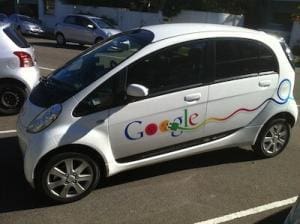How will the transportation of the future reduce its reliance on fossil fuels? Despite all its advantages, one of the biggest disadvantages of photovoltaics (PV or solar power), and most renewable energy sources, is the difficulty of storage and transport for later use. Storage of PV-generated power is inefficient without good batteries. You can fill up on petrol at any number of pumps throughout your neighbourhood, but where, if you looked now, could you find the power necessary to charge up a battery-operated automobile if you were out and about and your meter was verging on ‘E’? Innovative solutions are currently being experimented with by a number of forward-thinking companies in different regions throughout the world.
Better Place: Aiming to make Electric Vehicles a common sight
The electric car seems to have a bright future: one Israeli firm, Better Place, is currently planning projects in Israel, the EU, China, North America, and Australia, and elsewhere, to begin to build the infrastructure necessary for electric vehicles (EVs) to become more widespread. Likewise, ChargePoint, a US-based company that already has a foothold in some US cities, has also installed charging stations in the Sydney suburbs of Glebe, Pyrmont, and Rouse Hill, some of them for cars in the GoGet car-share fleet.
One of the aims of these companies is to propagate the use of means of transportation that are not fossil fuel-dependent. At the moment this is not necessarily the case, with 93% of Australia’s electricity production coming from conventional sources such as coal and gas. But the beauty of electrical power is that it is not necessarily bound to fossil fuels; it is possible to integrate renewables into electricity grids. Indeed, this is what the Australian federal and state governments have been actively encouraging since financial incentive schemes such as Feed-in Tariffs and Renewable Energy Certificates were introduced. This means that if you are in Australia, some percentage of the electricity coming out of your power points originates from a renewable energy source such as hydro, solar, or biomass. So while the power used to recharge the electric vehicle you might have is generated mostly by combustion of coal, the ratio of renewable power is set to increase–if all goes well, to more than 20% by 2020.
Addressing the issue of storage of renewable energy
One of the most innovative solutions that Better Place is proposing, however, would at least partially address the problem of storage. PV, wind, and other renewable electricity sources are subject to the whim of nature and therefore can be erratic and unpredictable, whereas coal-fired generation, for example, can produce steadily 24 hours a day, provided coal is available. To a power plant, coal is essentially stored energy–energy that is not required to be used it as soon as it is acquired. Electricity from wind and solar, on the other hand, must be used at the time that it is generated. A fleet of battery-powered vehicles parked overnight could help to solve this problem by providing a ‘distributed storage’ network to capture some of the spare generation capacity and feed it back into the electricity grid once an EV is fully recharged. This will be particularly important in a future where renewable energy generation is expected to increase, and resilience and flexibility will be more difficult to attain than with coal its cousins.
The future of charging infrastructure for Electric Vehicles
No one driving a car wants to get stuck without fuel, and for the time being it looks like electric vehicle drivers will have to take extreme care to ensure that their battery doesn’t run down in the middle of the desert–or even on a weekend trip out of town. One of the biggest challenges to the burgeoning electric car industry is to develop infrastructure such as charging stations, and to put together standards to ensure compatibility between different EV manufacturers. A few models of EV (e.g. Nissan Leaf, smart fortwo ED, the Holden Volt, and the Mitsubishi i-MiEV, among others) are already on the road or soon to debut, but the biggest manufacturers will mostly be competing in the same market. In one example of where it might be helpful to have universal compatibility, Better Place is currently trialing ‘switch stations‘, which would quickly swap a car’s spent battery out in exchange for a freshly charged one, so that the the driver would not have to wait for a recharge. Imagine the frustration you might feel as your battery comes close to flatness as you drive past a battery swap station for a type of electric car that is not yours!
Electric vehicles and renewable energy will need to work hand in hand in the future as conventional fuel prices go up and greener technologies become more mainstream and affordable. Although it may not necessarily take the form of the solar-powered car we’ve written about previously, solar power is certain to play a role in any future technological solution to the transportation fuel issue.
Written by James Martin
Solar Choice Analyst
Resources and Links:
Swan Energy: Solar Power and Wind Power Stations
Photo from themotorreport.net.au
Previous Solar Choice Blogs: Enhanced Renewable Energy Target : Renewable Energy Certificates : Stand-alone system battery maintenance : New solar car land speed record
- Solar Power Wagga Wagga, NSW – Compare outputs, returns and installers - 13 March, 2025
- Monocrystalline vs Polycrystalline Solar Panels: Busting Myths - 11 November, 2024
- Solar Hot Water System: Everything You Need to Know - 27 February, 2024
